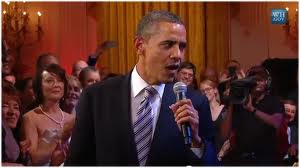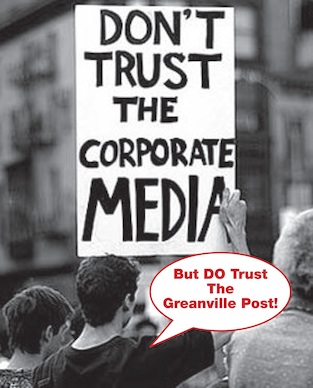Two Bubbles That Went Pop
Reflections on the Manipulation of Populism
When will Americans learn that the class a politician serves is the the only indicator worth considering in any political contest?
Long after its leading encampments have been torn down – often with brute force and (educationally enough) by predominantly by Democratic mayors and with the approval and involvement of a Democratic White House – the populist Occupy Movement deserves major credit for changing the United States’ political discourse. It helped bring the nation’s savage economic inequalities and the unmatched democracy-, society-, and ecology-destroying power of the wealthy Few (the instantly famous “1%”) into the national political discussion in ways that will give it a deserved place in future American history textbooks. It performed the remarkable service of calling out the name and address of the nation’s true unelected masters: corporate-financial capital and Wall Street.
Why did it emerge in the late summer and early fall of 2011? There were precursors and inspirations of from recent history that helped spark and explain the timing of the Occupy moment, of course: occupations of public space (Cairo’s Tarhir Square) to protest the rule of a dictator in Egypt and to protest neoliberal austerity measures in Spain and Greece; the December 2008 occupation of the Republic Door and Window plant on Chicago’s North Side; and the mass popular upheaval in Madison, Wisconsin in February and March of 2011 – a remarkable rebellion that included a 16 day people’s occupation of the Wisconsin State Capitol. Within New York City, not far from where OWS broke out, activists earlier the same year launched an outdoor encampment (“Bloombergville”) to protest Mayor Bloomberg’s plans to cut social services and jobs – an action that provided an interesting link between the Madison upheaval and Occupy, that utilized many of the same organizational methods that would he employed by Occupy movements across the nation, and that provided some of OWS’ early activists..
Only the 1 Percent Took Your House Away
Beneath and beyond these immediate sparks, however, there lay deeper developments that provided the fuel for Occupy’s sparks to catch fire. Occupy and the broader popular and populist spirit of sympathetic opposition to the rich and corporate few it helped capture arose when it did, I think, because of the bursting of two bubbles: the hyper-collateralized real estate, credit, and finance bubble of 2001-2007; the electoral-politics Obama hope and change bubble of 2007-2011. The popping of the first bubble – sparked by a wave of foreclosures in poor black and Latino communities that Wall Street had pumped with a wave of super-exploitive sub-prime home loans- laid bare the true elite and its culpability for the decline and indeed the breaking of American life and society. As Barbara Ehrenreich and John Ehrenreich argued in a December 2011 Mother Jones essay titled “The 1% Revealed,” the transparent crashing of the national and global economy by the financial shenanigans of the super-rich undermined the ability of the right-wing to credibly continue its longstanding fake-populist game of blaming the professional and managerial “liberal elite” for everything wrong in America. It exposed the real masters, “the 1 percent who are, for the most part, sealed off in their own bubble of private planes, gated communities, and walled estates.” Compared to the corporate and Wall Street elite, “professionals and managers, no matter how annoying, were [shown to be] pikers. The doctor or school principal might be overbearing, the professor and the social worker might be condescending, but only the 1 percent took your house away.”
The Class One Serves
The bursting of the second bubble reflected the realization that American democracy (or what’s left of it) is no less crippled by the dark cloud of big money and the many-sided machinations of capital when Democrats hold nominal power than when Republicans do. Elected in the name of progressive change and a promise to clean up corruption in Washington, the Obama administration has been a tutorial on who rules America and the underlying conflict between capitalism and democracy. With its monumental bailout of hyper-opulent financial overlords, its refusal to nationalize and cut down the parasitic financial institutions that had paralyzed the economy, its passage of a health reform bill that only the big insurance and drug companies could love, its cutting of an auto bailout deal that rewarded capital flight and raided union pension funds, its undermining of desperately needed global carbon emission reduction efforts at Copenhagen (2009) and Durban (2011), its refusal to advance serious public works programs (green or otherwise), its green-lighting of offshore drilling and numerous other environmentally disastrous practices, its roll-over of Bush’s regressive tax cuts for the rich, its freezing of federal wages and salaries, its cutting of a debt ceiling deal (in the summer of 2011) that was all about cutting social programs instead of tax increases on the rich, its disregarding of promises to labor and other popular constituencies, and other betrayals of its “progressive base” (the other side of the coin of promises kept to its Wall Street and corporate sponsors, who set new campaign finance records in backing Obama in 2008), the “change” and “hope” presidency of Barack Obama brilliantly demonstrated the reach of what Edward S. Herman and David Peterson call “the unelected dictatorship of money,” which vetoes any official who might seek “to change the foreign or domestic priorities of the imperial U.S. regime.” It richly validated radical analysts’ jaded take on the plutocratic reality behind the heavily personalized, candidate-centered “electoral extravaganzas” (Noam Chomsky) that big money and big media stage for the citizenry every four years, telling us that “that’s politics” – the only politics that matters. In its presidential as in its other elections, U.S. “democracy” is “at best a guided one; at its worst it is a corrupt farce, amounting to manipulation…It is an illusion,” the left historian Laurence Shoup observed in early 2008, “that real change can ever come from electing a different ruling class-sponsored candidate.”
John Pilger put it well at a socialist conference in San Francisco in July of 2009. “The clever young man who recently made it to the White House is a very fine hypnotist,” Pilger noted, “partly because it is indeed exciting to see an African American at the pinnacle of power in the land of slavery. However, this is the 21st century, and race together with gender and even class can be very seductive tools of propaganda. For what is so often overlooked and what matters, I believe, above all, is the class one serves.”
The lesson – driven home by the wildly unpopular elite-manufactured debt-ceiling crisis of July and August 2011 – suggested the wisdom of the late radical historian Howard Zinn’s clever maxim that “the really critical thing isn’t who’s sitting in the White House, but who is sitting in – in the streets, in the cafeterias, in the halls of government, in the factories. Who is protesting, who is occupying offices and demonstrating – those are the things that determine what happens.” As Zinn explained in an essay on the “election madness” he saw “engulfing the entire society, including the left” with special intensity early in the year of Obama’s ascendancy:
“The election frenzy seizes the country every four years because we have all been brought up to believe that voting is crucial in determining our destiny, that the most important act a citizen can engage in is to go to the polls and choose one of the two mediocrities who have already been chosen for us…… Would I support one [presidential] candidate against another? Yes, for two minutes-the amount of time it takes to pull the lever down in the voting booth…But before and after those two minutes, our time, our energy, should be spent in educating, agitating, organizing our fellow citizens in the workplace, in the neighborhood, in the schools. Our objective should be to build, painstakingly, patiently but energetically, a movement that, when it reaches a certain critical mass, would shake whoever is in the White House, in Congress, into changing national policy on matters of war and social justice.” (H. Zinn, “Election Madness, The Progressive, March 2008).
The Bubbles Co-Joined (2003-2008)
The two bubbles that burst have a curious linkage that goes back well before the collapse of Bear Stearns, Lehman Bros., AIG, and Washington Mutual. In an early May 2008 CounterPunch essay titled “The Obama Bubble Agenda,” the Wall Street veteran and left commentator Pam Martens reflected on a curious reason for high finance’s record-setting investment in the Obama campaign:
“The Wall Street plan for the Obama-bubble presidency is that of the cleanup crew for the housing bubble: sweep all the corruption and losses, would-be indictments, perp walks and prosecutions under the rug and get on with an unprecedented taxpayer bailout of Wall Street…..Who better to sell this agenda to the millions of duped mortgage holders and foreclosed homeowners in minority communities across America than our first, beloved, black president of hope and change?”
Obama, it should be remembered, did not step onto the stage of national celebrity and contention without first being carefully vetted by the financial and political investor class beginning in 2003. “On condition of anonymity,” Ken Silverstein reported in the fall of 2006, “one Washington lobbyist I spoke with was willing to point out the obvious: that bigdonors would not be helping out Obama if they didn’t see him as a ‘player.’ The lobbyist added: ‘What’s the dollar value of a starry-eyed idealist?’” (K.Silverstein, “Barack Obama, Inc.: The Birth of a Washington Machine,” Harper’s , November 2006 )
The favorable political credit rating given to Obama by the investor class reflected among other things his remarkable “yes” vote in the U.S. Senate on the so-called Class Action Fairness Act of 2005. A Republican bill backed and signed with great gusto by President Bush on February 18, 2005, it was a “thinly-veiled ‘special interest extravaganza’ that favored banking, creditors and other corporate interests” (Matt Gonzales) over and against workers, consumers, and the public by making it more difficult for ordinary people to sue corporate abusers. The bill had been long “sought by a coalition of business groups and was lobbied for aggressively by financial firms, which constitute Obama’s second biggest single bloc of donors.” (Silverstein). As Martens explained, that vile legislation amounted to “a five-year effort by 475 lobbyists, despite appeals from the NAACP and every other major civil rights group. Thanks to the passage of that legislation, when defrauded homeowners of the housing bubble and defrauded investors of the bundled mortgages try to fight back through the class-action vehicle, they will find a new layer of corporate-friendly hurdles.” (P. Martens, “The Obama Bubble Agenda,” CounterPunch, May 6, 2008, http://www.counterpunch.org/2008/05/06/the-obama-bubble-agenda/)
The Manipulation of Populism by Elitism
Ironically enough, Obama now gets to channel the populist Occupy spirit in fashioning his campaign for re-election against (in all likelihood) the spectacularly wealthy Mitt Romney. The Democrats are eager to portray Romney as Mr. 1%” and to identify Congressional Republicans with “those at the very top.” Liberal and Democratic activists, columnists, reporters, and politicians revel noting that Romney pays less than 14 percent on more than $40 million in mostly investment-based income over the previous two years “He makes more in one day than most American makes all year,” proclaimed the elite Democrat Gerald McEntee (president of the American Federation of State, County, and Municipal Employees, AFL-CIO), on the liberal-Democratic Huffington Post last month. Entitled “Mitt Romney and the 1%,” McEntee’s column described the leading Republican presidential contenders Romney, Newt Gingrich, and Rick Santorum, as “the candidates of the 1%, for the 1% and by the 1%” – as if Obama was not also such a candidate and not flying around the country raising vast sums of political capital from the nation’s financial elite at one push fundraising dinner after another.
The Democrats would certainly be campaigning against the Republicans along these anti-plutocratic lines even Occupy had never emerged. Knowing well that the majority of the population has for some time been deeply displeased with the wildly disproportionate wealth and power of the corporate and financial Few, they are old hands at what the late and formerly left Christopher Hitchens once described as “the essence of American poliotics…the manipulation of populism by elitism. That elite is most successful,” Hitchens wrote in a 1999 study of the Bill Clinton presidency, “which can claim the heartiest allegiance of the fickle crowd; can present itself as most ‘in touch’ with popular concerns; can anticipate the tides and pulses of public opinion; can, in short, be the least apparently ‘elitist.’ It’s no great distance from Huey Long”s robust cry of ‘Every man a king’ to the insipid ‘inclusiveness’ of [Bill Clinton”s slogan] ‘Putting People First,’ but the smarter elite managers have learned in the interlude that solid, measurable pledges have to be distinguished by a ‘reserve’ tag that earmarks them for the bankrollers and backers.”
Even the Republican candidates have not been able to resist the fake-populist campaign meme encouraged by the actually populist Occupy moment. Smarting over defeats in the Iowa Caucus and New Hampshire primary, conservative Republican presidential candidate Newt Gingrich went after Romney for eliminating thousands of jobs while amassing millions in personal wealth during his previous career as the CEO of the rapacious equity capital firm Bain Capital Management. “You have to ask the question,” Gingrich told reporters in connection with Romney’s economic record: “is capitalism really about the ability of a handful of rich people to manipulate the lives of thousands of people and then walk off with the money?” A Talking Points Memo article on Gingrich’s comment bore an amusing if not wholly accurate title: “Gingrich Goes Full ‘Occupy Wall Street’ on Romney.”
A Rick Perry ad in Iowa said that Romney “made millions buying companies and laying off workers.” Imagine! Perry went after Romney in South Carolina for talking about how he was once worried about receiving a “pink slip” himself. “I have no doubt that Mitt Romney was worried about pink slips, whether he was going to have enough of them to hand out because his company Bain Capital with all the jobs that they killed, I’m sure he was worried that he’d run out of pink slips,” Perry said.
Romney was compelled to release his tax returns – revealing his offshore tax havens and low overall tax rate (reflecting his utilization of a controversial filing method that is available only to wealthy investors) – partly under pressure from his Republican rivals.
But of course neither the Republican candidates nor Obama would ever admit something that I suspect many of the smarter Occupiers are able to acknowledge – that, yes, Newt, capitalism really is pretty much “about the ability of a handful of rich people to manipulate the lives of thousands of people and then walk off with the money.”
But that’s a topic for another essay.
Paul Street (www.paulstreet.org), an Iowa City resident, is the author or numerous books, including Racial Oppression in the Global Metropolis (2007), Barack Obama and the Future of American Politics (2008), The Empire’s New Clothes: Barack Obama in the Real World of Power (2010) and (co-authored with Anthony DiMaggio) Crashing the Tea Party
(Paradigm, 2011). Street can be reached at paulstreet99@yahoo.com.
_______________________________________________________________________________
¶
ADVERT PRO NOBIS
IF YOU CAN’T SEND A DONATION, NO MATTER HOW SMALL, AND YOU THINK THIS PUBLICATION IS WORTH SUPPORTING, AT LEAST HELP THE GREANVILLE POST EXPAND ITS INFLUENCE BY MENTIONING IT TO YOUR FRIENDS VIA TWEET OR OTHER SOCIAL NETWORKS! We are in a battle of communications with entrenched enemies that won’t stop until this world is destroyed and our remaining democratic rights stamped out. Only mass education and mobilization can stop this process.
It’s really up to you. Do your part while you can. •••
Donating? Use PayPal via the button below.
THANK YOU.
____________________________________________________________________________________________________








